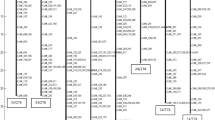Abstract
The systematic identification of the orthologous features of related organisms greatly facilitates comparative genomics, including research on genome evolution and comparative genetic mapping. In this study, we selected 274 unique gene sequences for the development of PCR-based genetic markers across fifteen legume genomes, representing six crop or model legume species from the phaseoloid and inverted repeat loss clades (IRLC). DNA sequence analysis demonstrated that 129 of the amplified fragments represented single copy loci across most target diploid genomes. The majority of these markers are intron-spanning (70.5%) and linked to legume genetic maps (85.3%). The markers were grouped into four main categories: (1) intron-spanning relatively conserved, (2) intron-spanning diverged, (3) exon-derived conserved, and (4) exon-derived diverged. The extent of sequence divergence within each category indicates that the corresponding markers may have utility for assessing phylogenetic relationships at different, but overlapping, taxonomic levels. We tested marker performance on genomes that had not been previously sampled, representing 95 different species that span the diversity of the Fabaceae. Phylogenetic analyses support the orthology of amplified sequences, with the notable exception of an ambiguous affiliation of Lotus relative to the IRLC and phaseoloid clades.





Similar content being viewed by others
References
Alvarez I, Wendel JF (2003) Ribosomal ITS sequences and plant phylogenetic inference. Mol Phylogenet Evol 29:417–434
Angiosperm Phylogeny Group (2003) An update of the Angiosperm Phylogeny Group classification for the orders and families of flowering plants: APG II. Bot J Linn Soc 141:399–436
Arabidopsis Genome Initiative (2000) Analysis of the genome sequence of the flowering plant A rabidopsis thaliana. Nature 408:796–815
Bruneau A, Forest F, Herendeen PS, Klitgaard BB, Lewis GP (2001) Phylogenetic relationships in the Caesalpinioideae (Leguminosae) as inferred from chloroplast trnL intron sequences. Syst Bot 26:487–514
Cannon SB, Zhu H, Baumgarten AM, Spangler R, May G, Cook DR, Young ND (2002) Diversity, distribution, and ancient taxonomic relationships within the TIR and non-TIR NBS-LRR resistance gene subfamilies. J Mol Evol 54:548–562
Causier B, Castillo R, Zhou J, Ingram R, Xue Y, Schwarz-Sommer Z, Davies B (2005) Evolution in action: following function in duplicated floral homeotic genes. Curr Biol 15:1508–1512
Choi HK, Kim D, Uhm T, Limpens E, Lim H et al (2004a) A sequence-based genetic map of Medicago truncatula and comparison of marker co-linearity with Medicago sativa. Genetics 166:1463–1502
Choi HK, Mun JH, Kim DJ, Zhu H, Baek JM et al (2004b) Estimating genome conservation between crop and model legume species. Proc Natl Acad Sci USA 101:15289–15294
Doyle JJ, Gaut BS (2000) Evolution of genes and taxa: a primer. Plant Mol Biol 42:1–23
Doyle JJ, Luckow MA (2003) The rest of the iceberg: legume diversity and evolution in a phylogenetic context. Plant Physiol 131:900–910
Fulton TM, Van der Hoeven R, Eannetta NT, Tanksley SD (2002) Identification, analysis, and utilization of conserved ortholog set markers for comparative genomics in higher plants. Plant Cell 14:1457–1467
Gaut BS (1998) Molecular clocks and nucleotide substitution rate in higher plants. Evol Biol 35:93–120
Kajita T, Ohashi H, Tateishi Y, Bailey CD, Doyle JJ (2001) RbcL and legume phylogeny, with particular reference to Phaseoleae, Millettieae and allies. Syst Bot 26:515–536
Koonin EV (2001) An apology for orthologs—or brave new memes. Genome Biol 2(4):1005
Lavin M, Eshbaugh E, Hu JM, Mathews S, Sharrock RA (1998) Monophyletic subgroups of the tribe Millettieae (Leguminosae) as revealed by phytochrome nucleotide sequence data. Am J Bot 85:412–433
Lewis G, Schire B, Mackinder B, Lock M (2005) Legumes of the World. Royal Botanic Gardens, Kew
Pennington RT, Lavin M, Ireland H, Klitgaard B, Preston J et al (2001) Phylogenetic relationships of basal papilionoid legumes based upon sequences of the chloroplast trnL intron. Syst Bot 26:537–556
Rokas A, Williams BL, King N, Carroll SB (2003) Genome-scale approaches to resolving incongruence in molecular phylogenies. Nature 425:798–804
Sanderson MJ, Shaffer HB (2002)Troubleshooting molecular phylogenetic analyses. Annu Rev Ecol Syst 33:49–72
Sang T (2002) Utility of low-copy nuclear gene sequences in plant phylogenetics. Crit Rev Biochem Mol Biol 37:121–147
Scherson R, Choi HK, Cook DR, Sanderson M (2005) Phylogenetics of New World Astragalus: screening of novel nuclear loci for the reconstruction of phylogenies at low taxonomic levels. Brittonia 57:56–66
Schlueter JA, Dixon P, Granger C, Grant D, Clark L et al (2004) Mining EST databases to resolve evolutionary events in major crop species. Genome 47:868–876
Small RL, Cronn RC, Wendel JF (2004) Use of nuclear genes for phylogeny reconstruction in plants. Aust Syst Bot 17:145–170
Soltis DE, Albert VA, Savolainen V, Hilu K, Qiu YL et al (2004) Genome-scale data, angiosperm relationships, and ‘ending incongruence’: a cautionary tale in phylogenetics. Trends Plant Sci 9:477–483
Swofford DL (2003) PAUP*, phylogenetic analyses using parsimony (*and other methods). Sinauer, Sunderland, MA, Version 4.0b10
Thompson JD, Gibson TJ, Plewniak F, Jeanmougin F, Hoggins DG (1997) The CLUSYAL-X windows interface: flexible strategies for multiple sequence alignment aided by quality analysis tools. Nucleic Acids Res 25:15
Wendel JF, Doyle JJ (1998) Phylogenetic incongruence: window into genome history and molecular evolution. In: Soltis DE, Soltis PS, Doyle JJ (eds) Molecular systematics of plants, 2nd edn. pp 265–296
Wojciechowski MF, Lavin M, Sanderson MJ (2004) A phylogeny of legumes (Leguminosae) based on analyses of the plastid matK gene resolves many well-supported subclades within the family. Am J Bot 91:1846–1862
Wolfe KH, Sharp PM, Li WH (1989) Rates of the synonymous substitution in plant nuclear genes. J Mol Evol 29:208–211
Acknowledgements
This study was supported by grant DBI-0110206 to DRC from the National Science Foundation Plant Genome Research Program, and DEB-0516673 from the NSF Systematic Biology Program to JJD.
Author information
Authors and Affiliations
Corresponding author
Additional information
Communicated by K. Shirasu
Rights and permissions
About this article
Cite this article
Choi, HK., Luckow, M.A., Doyle, J. et al. Development of nuclear gene-derived molecular markers linked to legume genetic maps. Mol Genet Genomics 276, 56–70 (2006). https://doi.org/10.1007/s00438-006-0118-8
Received:
Accepted:
Published:
Issue Date:
DOI: https://doi.org/10.1007/s00438-006-0118-8




